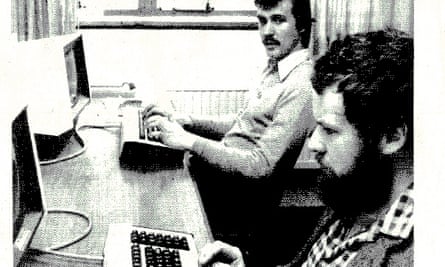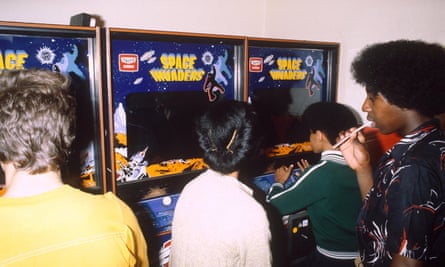15. Pong (1972, Atari)
It wasn’t the first video game; it wasn’t even the first ping-pong game – Table Tennis on the Magnavox Odyssey got there earlier. Pong was, however, the game that kickstarted the video arcade and home console industries, the profitability of its hardware and the simplicity of the gameplay – just two bats, a ball and a scoring system – ensuring its huge success and iconic afterlife.

14. Mattel Auto Race (1976)
Widely considered the first handheld video game, Mattel Auto Race used a grid of red LEDs to simulate a simple race track, the player avoiding incoming dots to keep driving as a timer ticked down. Devised by development engineer George J Klose as a means of repurposing calculator chips, it was a big success, leading to Mattel’s legendary American football and soccer titles, and no doubt piquing the interest of a certain Nintendo engineer …
13. Computer Space (Nutting Associates, 1971)
Included as much for its beautiful retro-futuristic cabinet design as the game itself, Computer Space was the first commercially available video arcade game, built by Atari founders Nolan Bushnell and Ted Dabney a year before the arrival of the much more successful Pong. It’s a formative space shooter, with the player battling two computer controlled UFOs amid a rudimentary star-scape, but it’s that curvaceous fibre glass cabinet (which earned the game a cameo in the 1973 sci-fi movie Soylent Green) that we’ll always remember.
12. Sea Wolf (1976, Midway)
One of the most beautiful painted cabinets of the mid-70s, Sea Wolf was inspired by Sega’s late-60s electro-mechanical game, Periscope, but added a monochrome video display instead of cardboard ships and plastic waves. Players aim and fire at passing battleships, targeting them via a rotating periscope fixed to the front of the cab. Its success inspired the nascent arcade industry to experiment with elaborate novelty interfaces, a factor that proved vital in maintaining the success of the coin-op industry as home consoles proliferated.
11. Western Gun (1975, Taito)
Alongside Tank, Western Gun (known as Gun Fight in the US) helped lay the foundations of the multidirectional shooter genre, allowing two players to navigate a cactus-strewn landscape, blasting six-guns at each other until one cowboy fell. Among the first games to feature human v human combat, it was almost as influential as designer Tomohiro Nishikado’s later project, Space Invaders.
10. The Oregon Trail (1971, Don Rawitsch, Bill Heinemann, and Paul Dillenberger)
The classic educational game, originally coded for the HP-2100 minicomputer, The Oregon Trail challenged American schoolkids to lead a caravan of settlers from Independence, Missouri, to the Willamette Valley in Oregon, hunting and trading en route. An early entry into the survival genre, it remains one of the surprisingly few video games in which players can repeatedly die of dysentery.
9. MUD 1 (1978, Roy Trubshaw, Richard Bartle)

Programmed by Roy Trubshaw on Essex University’s DEC PDP-10 mainframe, MUD (Multi-User Dungeon) 1 took the text-based game design of Colossal Cave Adventure and Zork and added the ability to play alongside other participants via internet connection, thereby capturing the vital social element of traditional D&D. Its legacy includes virtual worlds such as Second Life, but also the massively multiplayer online RPG genre popularised by World of Warcraft.
8. Zork (1977, Tim Anderson, Marc Blank, Dave Lebling, Bruce Daniels)
Written by a group of MIT students in 1977 and inspired by formative text game Colossal Cave Adventure, Zork built on the burgeoning dungeon exploring genre with a richer narrative and lots of humour. The game was ported to a vast range of early computers and inspired several sequels, leading to the formation of Infocom, one of the most influential adventure game studios in history.
7. Sprint 2 (1976, Kee Games)
Overhead-viewed racing games were rife in the 70s but Atari’s Sprint titles were the ones I preferred on my childhood jaunts around Blackpool arcades. Using the 6502 microprocessor that would later power Atari’s home consoles, it’s an exciting two-player racer with breakneck speed, responsive handling and 12 different circuits to zoom through. Hugely influential to a whole era of video games including Micro Machines, Indy Heat and Amiga great, Ivan “Ironman” Stewart’s Super Off Road.
6. Star Raiders (1979, Atari)
The original first-person space combat sim, Star Raiders was way ahead of its time when coder Douglas Neubauer wrote it for the Atari 800 computer, inspired by Star Wars and old Star Trek text adventures. You play as a starship pilot protecting airspace against the invading alien Zylon fleet. The combat is fast and tactical, and, due to the limited amount of fuel, players had to carefully plan each attack, docking in space stations to fill the tanks between shootouts. Stylish, intense and incredibly immersive, it was a clear influence on later genre greats Elite and Wing Commander.
5. Lunar Lander (1979, Atari)
The first moon landing simulation was written by school student Jim Storer in the weeks following the Apollo 11 mission, on an old PDP-8 minicomputer. Years later, Atari coder Howard Delman decided to use a similar concept to test Atari’s new vector graphics technology and Lunar Lander went into production. As with Asteroids, the stark visuals give the game an authentically serene atmosphere, and the super-sensitive thruster controls are a real test of the player’s piloting skills. The game was never a big hit and, as Asteroids took off, Atari repurposed Lunar Lander cabs to run the newer title. However, its legacy lives on in titles such as Gravitar and Thrust, and it remains a design classic in its own right.
4. Breakout (1976, Atari)
After the success of Pong, Nolan Bushnell wanted a single-player game that could use a similar paddle controller – so he flipped the Pong playfield on its side, replaced the second player with a brick wall and got Steve Jobs (then an Atari employee) and Steve Wozniak to produce a prototype. The result is the archetypal arcade puzzler – straightforward in concept but hugely demanding and open to player tactics and finesse. It would inspire generations of screen-clearing games, from Arkanoid to Peggle.
3. Space Invaders (Taito, 1978)

Designed by Tomohiro Nishikado, who took inspiration from Atari’s Breakout, Space Invaders was the first hit arcade game to cross over into mass cultural consciousness – and it’s still there. Its implementation of early shoot-’em-up conventions, its iconic alien designs (based on various sea creatures) and its sparse, perfect soundtrack are part of the DNA of the games industry. From smartphone emojis to street art, Space Invaders will always be the visual symbol of gaming.
2. Asteroids (1979, Atari)
A lone ship trapped in a dangerous asteroid field with only a laser gun and the physics of thrust and inertia to protect it. This was the premise behind Lyle Rains and Ed Logg’s wonderful multi-directional shooter, inspired by an abandoned Atari project named Cosmos that involved two players stealing planets from each other. The pinpoint sharp vector graphics and brilliant controls (tweaked for months by Logg) made for a uniquely challenging and aesthetically pleasing game that still absolutely stands up today.
1. Galaxian (1979, Namco)
Space Invaders got there first, but Galaxian showed us the future of the space shooter genre with its crisp, multicolour graphics, dive-bombing enemies and twinkling starfield backdrop. The game also used rudimentary AI to give attacking craft different behaviours – a feature Namco would return to via Pac-Man’s ghosts. A masterpiece in its own right, Galaxian would lead to two superlative sequels, Galaga and Gaplus. Alongside Phoenix and Gorf, this timeless trilogy represented the high point of the fixed shooter era before the likes of Xevious, Defender and Sinistar brought us into the age of scrolling landscapes. More of that in the 1980s…

Comments (…)
Sign in or create your Guardian account to join the discussion